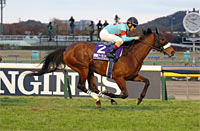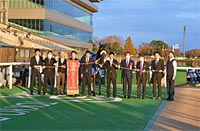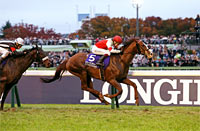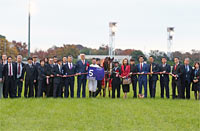Japan Cup (G1) - Comments from runners' connections

Cheval Grand
Yasuo Tomomichi, trainer
“Two races ago the ground was pretty bad and I think that hurt. And last time out I think the course suited him but the distance was a bit short. He’s not good with a slow pace where everything comes down to the final stage. After he went through quarantine we sent him to the farm before returning to the training center with this race as our target. Christophe Soumillon rode him on Nov. 13 and the first thing he said afterward was that the horse was not well forward. He’s always been rather lackluster in morning work but does well at the racetrack. As far as I can tell he’s well recovered from his travels and I think the jockey has got a good handle on him with this workout. I think the Tokyo 2,400 meters is his best trip. He doesn’t have a great turn of foot but he can run well at length. I think the jockey will be able to bring out the best in him.” |
|

Curren Bouquetd’or
Sakae Kunieda, trainer
“In the Shion Stakes, she was coming back after a layoff and was overly eager, but that race settled her down, so she did well in the Shuka Sho. There, right at a decisive point, things got tight on the inside, but she did gain ground nicely after that. She lost but it was a good race. I kept her at the training center to prepare for here and she’s kept her weight and looks to be getting better with each race. I did think of running her in the all-female Queen Elizabeth II Cup but she has done well at Tokyo and the 53 kg she’ll be carrying puts her at an advantage. I don’t think it’s fair to compare her to last year’s winner Almond Eye, and not being popular will keep the pressure off. Even up against male and older horses, she has a chance.” |
|

Daiwa Cagney
Takanori Kikuzawa, trainer
“Looking at his last two starts after he returned from time off, he was in better condition for the Niigata Kinen the start before last than he’d been in a while and it being a lefthanded track, I had my hopes up. But breaking from the inside gate he got knocked about a lot and in the end he didn’t want to run. Last out, I switched back from cheekpieces to blinkers and he was able to move in from the outside gate to second position and race smoothly from there, which factored in the win. It was a good race and he came out of it well. I gave him a bit of time off after that last race, then aimed him here. His muscling is good and so is his movement. Getting bumped around really exhausted him but he’s a lot stronger now. If he can lead and run his own race, I think he’ll be able to handle 2,400 meters. The lineup is strong but if he gets the trip he likes, I think he can finish on the board.” |
|

Danburite
Hidetaka Otonashi, trainer
“In the Kyoto Daishoten he was returning from a fracture, but it had been a very small one. I think he was in good shape, started well and was able to run his own race. And being able to handle the distance well was quite a gain. It was a good, solid race. After that, I gave him a bit of time off at the farm and since then he’s been worked with this race as our target. On Nov. 13, he worked with Mozu Superflare in front and he didn’t quite catch up, but then she’s a sprinter. Still, this horse had final laps of 12.4-12.3 seconds, so it was adequate. He’s not good up against horses with a sharp turn of foot but he’s good at running well at length, so I’m hoping the race will unfold in a way that favors those with stamina. He doesn’t need to lead, so if there are others that go to the front, he can stay within striking distance. I’d like to have a bit of spring in the ground.” |
|

Etario
Yasuo Tomomichi, trainer
“He’s been in good shape but his mental state is more of a problem. These past two starts, I feel that he just doesn’t want to run. I had switched him to shallow blinkers before the Tenno Sho(Spring), but went back to the deeper ones. And that did seem to have a good effect in morning work. On Nov. 13, he looked quite eager to run. In his races, it seems that he doesn’t switch on totally and he’s had a run of seconds. In the Tokyo Yushun(Japanese Derby), even with the runners close to the pace holding their ground, he moved up from near the rear to finish in fourth. I think Tokyo suits him. The jockey and I both think he’ll switch on.” |
|
|
Jinambo (colt, 4)
Kazutomo Mori, assistant trainer
“He’d only been raced at Tokyo and Nakayama, so his last race was his first time to ship to Niigata. He was calm and I think that helped him run well. It was his first open-class race and a graded-stakes race at that. He got good results and it looked like he’s coming into his own. After that he went to the farm and has had a good solid month of work since coming back to the training center. He weighed in at 488 kg on Nov. 12 and all is going well. The competition is a lot tougher, but he has gained experience and gotten results and he’ll be in good shape and I’m expecting good results. He’s been keen in a 2,400 meters race before but if he can stay calm with the start in front of the grandstand, I think the distance itself is not a problem.” |
|

Look Twice
Nobuyuki Tashiro, assistant trainer
“In the Copa Republica Argentina the pace was slow but he gained ground from about midpack in the final stage. He’d had a long vacation before that but he did look good in places. It was his first open-class race and he was running under 57 kg but he gave it his best and I think he took a lot away from that race. There was no damage and his prep has gone well. He trained up the hill course on Nov. 14 and his movement was good. There are only two full weeks between races so there’s no need to push him too hard in work. He’ll be dramatically improved. One good thing is that he’ll be running under the same weight as last race. And the wide-open lefthanded track suits him. He’s actually set a record at this course. And he no longer loses concentration when he needs it most. He has matured and because he rises to meet the level of the others, I think he’ll be able to hold his own in a Grade 1.” |
|

Makahiki
Yasuo Tomomichi, trainer
“In the Tenno Sho(Autumn), at 2,000 meters and with those near the front not slowing down, he was chasing the others the entire time and unable to keep anything in the tank. Still, he was able to gain some ground in the stretch. I gave him about a week off at the farm and then targeted him here. He worked over the artificial track on Nov. 13 with two others. I don’t know if it’s due to his age but he isn’t able to chase down the others like he could when he was 3 years old. Still, he moves well and his time isn’t bad. I’d say his condition has stabilized. I plan to run him in cheekpieces like he wore last out. The extra distance this time will make things easier for him. He hasn’t gotten the best results in his last two starts but he did well in the Kyoto Kinen and the Osaka Hai so I don’t think he’s deteriorating. I’d like to see a Tokyo 2,400 meters like he showed us in the Derby.” |
|

Muito Obrigado
Koichi Tsunoda, trainer
“He started really well in the Copa Republica Argentina and went right up to third position and rode the pace well. In the stretch it opened up for him and he moved out solidly when urged on, and never gave up until the end. It was a very good race. He came out of that fine and worked in tandem on the flat Nov. 15. He has the trip to the track so I pushed him hard then. He’s come along as planned and though he was in good shape for his last race, I think he’ll be sharper with that last start. It’s a strong lineup but with the wide-open Tokyo track and long stretch, this distance is best for him. The jockey has ridden three races and won twice and has a good handle on him, so that gives me confidence. We’ll do what we need to up to race day and hope the race unfolds to his liking. Shifty ground is no good, so I’m hoping for a fast track.” |
|

Rey de Oro
Daisuke Tsumagari, assistant trainer
“He started the year with the Dubai Sheema Classic and the Takarazuka Kinen and he lost in a way uncharacteristic for this horse. Coming back in the fall he had the Sankei Sho All Comers. To be honest, I was worried, but it was a solid race. He finished fourth but overall the race was quite different from his two other starts this year. I think he’s back. He returned to the training center on Oct. 30. He’s always improved this time of year and his muscling for one is back to what is normal for him. Last week, he worked in tandem with another, running up on the inside. All looks good. At Nakayama, he tends to get left behind at the crucial point but at Tokyo he can stretch out and run and I think the course suits him best. I’m hoping he’ll live up to expectations.” |
|

Suave Richard
Yasushi Shono, trainer
“In the Tenno Sho(Autumn) he traveled behind the winner and things went well over the first half, with the pace easing off at times. He couldn’t respond to that quickly enough so at a crucial point he put distance between himself and the winner. He stayed at the training center after that. He’s lean because he just raced and his muscles are nice and full. I had the jockey ride work up the hill last week and so he wouldn’t overdo it, I had him focus only on the final stage. He looks to have gotten a good reading on him and the horse is just right. He raced here last year and considering that it was won in record time, I think he did well. This time it's two furlongs longer than his last start and he’ll have to take a breather somewhere so his should respond different where it’s most needed. He’s gotten a little too clever as he’s matured so I’m hoping he’ll stay focused until the end.” |
|
|
Taisei Trail (colt, 4)
Shigeki Miyauchi, assistant trainer
“I always had the impression that he was more suited to a track with tighter turns, but last out in the Copa Republica Argentina at Tokyo, he traveled from further back than usual and ran very well in the final stage. To run that kind of race at Tokyo is really something. He seems to have gotten better with each race. He’s had regular work since and looks to have improved. There are only two full weeks between races and our usual stable routine is to breeze him over the woodchip course on the Friday before race week. His times in work aren’t great and that’s about what it was. The competition goes up a notch, but he should hold up well with no major problems. I’m hoping he’ll show us some good racing even in a Grade 1.” |
|

Wagnerian
Yasuo Tomomichi, trainer
“He’d lost two shoes in the Sapporo Kinen, and though I’d had my hopes up for the Tenno Sho (Autumn) over the Tokyo 2,000, he finished in fifth place. Considering that he had drawn the No. 14 gate, I don’t think it was a bad race by any means. We sent him to the farm for only about a week after that and brought him right back to the training center. He’d needed a lot of time to recover from the Kobe Shimbun Hai and we couldn’t race him for quite a while, but his constitution has finally gotten a lot stronger. On Nov. 14, he worked alone up the hill course and clocked 82.5 seconds with a last furlong time of about 12 seconds. If he trains with another horse he really runs so with not much time between races, this is enough. Whether he races to the right or to the left makes no difference but the long stretch is a plus and 2,400 meters is no problem. Now that he’s stronger, even with three full weeks between races he’ll be able to do well.” |
|

Win Tenderness
Haruki Sugiyama, trainer
“Last out in the Copa de Republica Argentina, he got a good position and a smooth trip but he wasn’t able to quicken enough in the final stage. I thought he’d do a bit better. His morning work was good but with it being his first race since the one where the jockey fell off, it looked more like a start right off a layoff. He’s not quiet in the gate, so I’ve given him practice by tying him in the gate. Hopefully he’ll be quiet on race day. He’d always done well with a sharpener. And though his results haven’t been good lately, I think we can expect improvement. We’ll just have to see how much.” |
|

You Can Smile
Yasuo Tomomichi, trainer
“He has always done well over 2,000 meters and he won the Niigata Kinen over that distance, so I was looking forward to seeing how he’d do up against top-class horses in the Tenno Sho(Autumn). He didn’t quite make it to the top, but he did gain ground nicely in the stretch. He’s stronger. His fast work on Nov. 14 was on the flat woodchip course. I had him catch and pass another horse with a focus only on the final stage. With little time between races, this should be enough. He’s gotten more solid since this time last year. His hindquarters are well balanced now and he can run straight. I think he could race to the right now, but I’m giving him what he likes once more, racing to the left. At this distance, things should be easier for him as well. He bided his time in the Diamond Stakes (G2, 3,400 meters, Tokyo), then shot up the inside for the win. I think he can do the same thing over 2,400 meters.” |
|
Sources: Keiba Book, Netkeiba
|

- Preview
- Barrier draw
- Past performances of runners

- News
- Race result
- Video
- 2020 English

- 2019 English

- 2018 English

- 2017 English

- 2016 English

- 2015 English

- 2014 English

- 2013 English

- Photo Gallery
2020 Winner: Almond Eye



2019 Winner: Suave Richard


|





